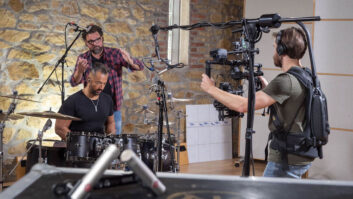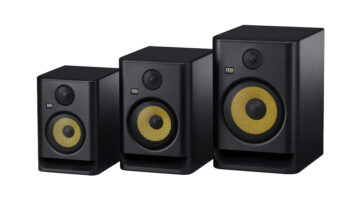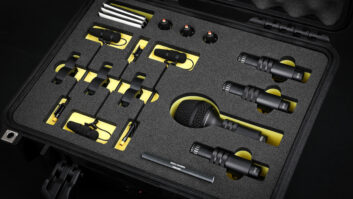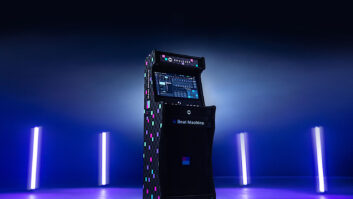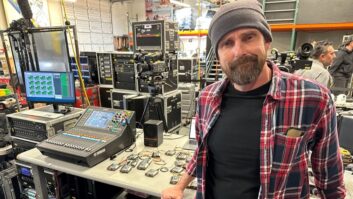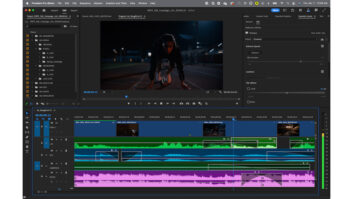By Janice Brown
February 2007–While drums are generally regarded as one of the few lasting “live” tracking imperatives, drum programming and rhythm track enhancing software tools are some of the great collaborators in music production. For electronic music producers and remixers, drum programming is a skill- and toolset to be constantly refined, but recording engineers working in almost any musical genre will be similarly empowered by having realistic beats on hand for demos, and programming and sound replacing options at the ready throughout the course of a project.
The following submissions on drum programming technology and techniques illustrate the universal utility of these tools once adopted–from mapping out the BPM of a demo, to generating initial beats, to composing or layering live tracks with drum samples.
Lee Groves (www.leegroves.com; Goldfrapp, Gwen Stefani, Depeche Mode), U.K.-based producer/remixer and Mark “Spike” Stent’s programmer is a self-proclaimed “Logic man, through and through.” Contemplative Lee Groves Though he usually works with live drums, he’ll add kicks and snares to existing multitracks when programming for Spike. Groves runs down his tools of choice: “Firstly, the ‘Enhance Timing’ plug-in on Logic can work wonders on a drifting drum track. Secondly, I use a fantastic plug-in called, ‘ApTrigga’ which is exactly like ‘Sound Replacer’ and has zero latency; it’s amazing for zooming in and replacing kicks, snares, whatever you want. Thirdly, I’m loving Melodyne; it’s fantastically good at tightening up and mashing up drum tracks, too.
“IK Sampletank comes with an awesome array of drum sounds, all velocity mapped and fat, and I also use a lot of the Apple Jam Packs instrument patches for Logic’s EXS-24 sampler. While I always record my own drums, I’ve messed around with FXpansion’s BFD, and that gives some great rock sounds. Logic’s Ultrabeat is amazingly flexible at creating lunatic electronic drums.
“If I need to, I’ll ReCycle a drum loop and put it into Reason, which I ReWire into Logic; it’s great fun messing around with drums in Reason, either as REX files or in ReDrum. And, IK’s Sampletank 2.0 has a ‘Stretch’ facility for real-time re-sampling and pitch/time stretch, which you can get some mad drum effects with. Logic’s EXS-24 is very flexible, too. It’s that ability to take things outside the norm which creates truly original sounds, and Logic allows you to do this.”
Carmen Rizzo (www.carmenrizzo.com; Seal, Alanis Morrissette, Coldplay) is an electronic artist as well as a producer/remixer, whose belief that one’s “style and sound must be a factor that divides you from the rest” motivates a constantly evolving sonic palette. Carmen Rizzo doing his thing using M-Audio controllers”I always try to layer my own custom sounds into in-the-box stuff,” Rizzo notes. “For my own music, I try to use abstract sounds to create beats. I use Pro Tools for recording and sequencing, and I make drum sounds using Native Instruments Battery 3, Reaktor, Kontact, Spectrasonics Stylus, and IK Multimedia’s Sample Tank and Sonic Synth. Actually, Battery 3 is always used, and at times I program the Korg Electribe drum machines.
“I was a big MPC user from day one, but I’ve loaded all my samples into Battery; Pro Tools does a wonderful job of creating the ‘swing’ feels from the MPC, as does Logic and Cubase. And, Ableton Live is wonderful for auditioning loops.”
Fabrice “Fab” Dupont (www.fabulousfab.com; Toots and the Maytals, DJ Mark Ronson, Lucy Woodward) creates his drum demos using Submersible Music’s Drumcore, Digidesign’s RTAS virtual drum kits, Strike, or REX libraries in Propellerhead Reason. “Between these two packages, and some of my REX loop libraries playing from Reason, I always get what I need to write and arrange the track and show the drummer what he needs to do,” Fab, the producer/engineer, offers. “Sometimes, elements of the demo groove stay in the final track as hits or fills or even under-layers to beef up the real drums.”
Fab in his “Dangerous” NYC StudioHe reviews, “Drumcore rocks because the company hired top drummers like Matt Sorum and Sly Dunbar to play the grooves and they really had a clear vision of how people would use their stuff. I always find something cool in there and torture to fit my needs. Strike is different in the fact that it’s recreating the grooves in real time; they may not feel as funky as the Drumcore library, but you can alter them and change the sounds, including mic position and bleed. It feels human and has some percussion loops and other sounds that are useful on every song.”
As for straight drum programming, Fab, “the artist and songwriter,” notes, “Most of my beats are programmed with individual samples that I’ve collected over the years from my own mixes–old Akai libraries, door slams, old beat boxes, broken synths, modified purchased libraries, etc. The library is a work in progress. It defines my sound, and I always add to it, modify it, learn it. It’s like an instrument itself.”
To play this instrument, Fab has settled on the FXpansion GURU software package running on an OpenLabs Miko workstation, saying it gives him the benefits of a hardware-based sequencer/sampler/production center, “without the limitations. The Miko touch screen lets me ‘touch’ the pads on GURU like if it was a live drum pad, the keyboard lets me ‘play’ the samples like synth sounds, and the Miko hardware controllers are all assigned to the principal functions like volume, pan, pitch, attack, release, sample start for every sample. GURU plays samples and/or loops, has its own beat-slicing algorithm, plays REX files, and is very solid timing-wise. It feels very MPC-like, with less menu browsing.
“I use Pro Tools 7.3 with GURU running as a plug-in and Drumcore and Reason ReWired to it, all on the Miko. It’s like having a computer workstation in keyboard drag. Having all packages running on the same machine alleviates the sync problems to a great degree.” Finally, says Fab, “I print everything to my Pro Tools HD TDM rig and mix it there with analog hardware and summing boxes.”
Producer/composer Glenn Schloss (www.gemusic.com; G$, ESPN Sportscenter, Discovery Channel, VH1, HBO) is actually a drummer, and triggers the Reason NN-XT sampler and Bob Clearmountain’s Drum samples, on his new Roland TD-20S V Pro drum kit. Glenn rocks out on his new Roland TD-20S V Pro Drums with TD-20 sound module at his NYC studio”Reason drum templates are excellent and easy to navigate with Pro Tools via Rewire,” Schloss offers. “The built-in drum machines are simple to program and great for instant grooves. But even better is the Reason NN-XT sampler. You can build and construct amazing kits. There’s no limit to what you can import into the NXT sampler between AIFF and .Wav files.”
Schloss adds, “The [FXpansion] BFD sounds are also top-notch: There are so many options with the different mics and kits to choose from, and you have the flexibility to play with the direct mics and room mics after you record them. You have so much power being able to split the drums out all of your faders. It feels and tastes like you’re engineering real drums.”
Schloss continues to expand his palette of sounds: “Every few months, we’ll order up a couple of sample libraries, take inventory on the good stuff and cut those up into Reason templates or throw them into Ableton Live. Bashiri Johsnon has some of the most incredibly recorded percussion sounds. Those grooves are great for adding layers on existing drum beats. Also, the Stylus RMX software is amazing–very functional and plug-and-play stuff with features that allow you to split up the groove and manipulate split-out elements.”
For making electronic music, Schloss favors the Korg Electribe series and plays two or three boxes in real time via MIDI as a “starting point for creating original loops.” His “all-time inspiring drum program,” however, is Ableton Live, into which he can drop loops in a sequence and play on top of them. “The tempos and loops are so flexible,” Schloss notes. “There is no limit to what you can do with Live–loop, layer and add effects all in real time, without stuttering and stopping. It’s all very spontaneous, which ultimately makes you play things that you never would have otherwise dreamed up.”
Samples and loops are also a big part of composer/remixer J. Chris Griffin‘s (www.myspace.com/syntheticmess; John McLauglin, Kelly Clarkson, Madonna) sound. J. Chris Griffin in his studio, located within the new Cutting Room Studios in Manhattan.”To stay organized, I have individual samples key-mapped in Reason NN-XT according to instrument–kicks, snares, hats, percussion,” Griffin shares. “For example, I have four or five NN-XT patches with nothing but kick drums spread out over the length of the keyboard, so when I need a kick drum, I just load up the patch in Reason, and play the different notes on the keyboard until I find the drum I like.
“I was one of the first people to use Digidesign’s Stryke plug-in, and have found that using an M-Audio Ozonic or X-Session controller works wonders for the resulting track. It is very easy to route a knob or slider to one of the onscreen controls. Though Stryke is one of the best tools out there, I always hire a seasoned studio player for sessions. For filter-electronic drum sounds, using the M-Audio X-session to control parameters in Ableton Live is a real blessing. With a twist of a knob I can control the sound of the entire drum kit, and for me, it brings back a performance element that programmed drums so often miss.”
Making music “in the box” gets a bad rep; these guys clearly get inspired by software programs in a way they wouldn’t have been without them. Griffin offers, “Ableton Live is an amazing tool. Sometimes I just load up a ton of loops inside Live to see what happens. Though I have never been a ‘loop construction’ programmer, Live allows me to assemble a ‘soundset’ of loops, and the resulting track always inspires a new concept for production.”
Schloss summarizes, “For me, loops have become the new clicks. I find it more interesting to play over a drum loop vs. a cowbell click when I begin a project. It’s so easy to dial up a quick loop and start recording your ideas. My three quick click choices are the Stylus RMX, the Korg Electribe and Ableton Live.” Furthermore, Schloss has incorporated Live into his studio productions, and live performances. “I’ve built an entire live performance show around Ableton Live which controls all of my drum sequences and most of my melodic components as well. I play keyboard and percussion all tied up on a lighting truss with a keyboard and Ableton centered in the middle of all the action. I also have three live players on stage with me and another DJ triggering samples.”
